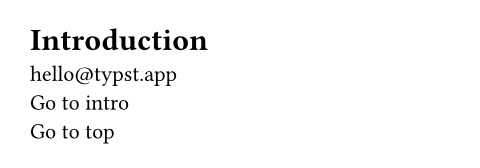翻訳済み
このページは日本語に翻訳済みです。
link要素関数要素関数要素関数はsetルールやshowルールでカスタマイズできます。
要素関数
要素関数は
setルールやshowルールでカスタマイズできます。URLや文書中の位置へのリンク。
デフォルトでは、リンクの外見は通常のテキストと変わりません。 しかし、showルールを使うことで、簡単に任意のスタイルを適用できます。
例
#show link: underline
https://example.com \
#link("https://example.com") \
#link("https://example.com")[
See example.com
]

ハイフネーション
ハイフネーションや両端揃えを有効にしていても、意図しないURL中のハイフネーションを防ぐため、
デフォルトではリンクには適用されません。
これを無効化するには、show link: set text(hyphenate: true)を使用します。
構文
この関数には専用の構文もあります。
http://やhttps://で始まるテキストは、自動的にリンクに変換されます。
引数引数引数は関数への入力値です。関数名の後に括弧で囲んで指定します。
引数
引数は関数への入力値です。関数名の後に括弧で囲んで指定します。
link(,)->dest必須引数必須引数必須引数は、関数を呼び出す際に必ず指定しなければなりません。位置引数位置引数位置引数は順序通りに指定することで、引数名を省略して設定できます。
dest必須引数
必須引数
必須引数は、関数を呼び出す際に必ず指定しなければなりません。
位置引数
位置引数
位置引数は順序通りに指定することで、引数名を省略して設定できます。
リンクの遷移先。
-
Webページにリンクする場合、
destは有効なURL文字列である必要があります。mailto:やtel:のURLスキームを含むURLが指定され、 かつbodyパラメーターが省略された場合、 URLスキームを除いたメールアドレスまたは電話番号がリンクの本文になります。 -
文書中の別の部分にリンクする場合、
destには次の3つのうちいずれかの形式を用いることができます。
例を表示
= Introduction <intro>
#link("mailto:hello@typst.app") \
#link(<intro>)[Go to intro] \
#link((page: 1, x: 0pt, y: 0pt))[
Go to top
]

body
bodyリンクとして表示するコンテンツ。
destがURL文字列の場合、このパラメーターは省略可能です。
この場合、URLがリンクとして表示されます。